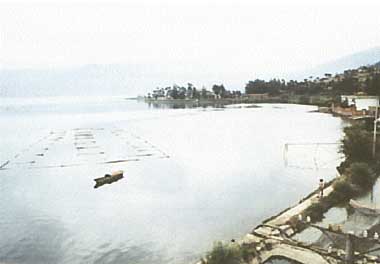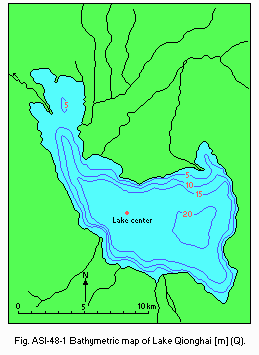QIONGHAI-HU (LAKE QIONGHAI)
A view on the lakeshore

Photo: Sichuan Environmental Protection Committee
A. LOCATION
- Sichuan Province, P.R. China.
- 27:48-27:52N, 102:16-102:21E; 1,508 m above sea level.
B. DESCRIPTION
Lake Qionghai, the second largest lake of Sichuan Province, is located in Xichang City, Liangshan Yi Nationality Autonomous Region. The tectonic lake measures 11.5 km from northwest to southeast. It is a semi-enclosed fresh water lake and has only one outlet, Haihe River, on the north. It flows into Anning River, one of the subtributaries of Changjiang River.
Since a chemical fertilizer factory in the north was moved away in 1979, there are almost no industry sites around Lake Qionghai. Domestic sewage and industrial wastewater from Xichang City discharge into Haihe River, without impact on the lake water. So the main pollution source is farmland runoff, and sewage from schools, hotels and a hospital nearby.
In the lake, with good water quality, there are plenty of flora and fauna. More than 30 fish species have been described. The maximum annual fish catch was up to 680 tons, including fish 450 tons, shrimp 20 tons and crab 110 tons (Q).
C. PHYSICAL DIMENSIONS (Q)
| Surface area [km2] | 31 |
| Volume [km3] | 0.32 |
| Maximum depth [m] | 34 |
| Mean depth [m] | 14 |
| Water level | Unregulated |
| Normal range of annual water level fluctuation [m] | 2 |
| Length of shoreline [km] | 35 |
| Residence time [yr] | 2.7 |
| Catchment area [km2] | 300 |
D. PHYSIOGRAPHIC FEATURES
D1 GEOGRAPHICAL
- Bathymetric map: Fig. ASI-48-01.
- Names of main islands: None.
- Number of outflowing rivers and channels (name): 1 (Haihe R.).

Fig. ASI-48-01
Bathymetric map [m](Q).
D2 CLIMATIC
- Climatic data at Xichang Meteorological Station, 1988
| Jan | Feb | Mar | Apr | May | Jun | Jul | Aug | Sep | Oct | Nov | Dec | Ann. |
| Mean temp. [deg C] | 9.5 | 11.8 | 16.4 | 19.5 | 21.2 | 21.1 | 22.6 | 22.2 | 19.9 | 16.8 | 12.9 | 10.0 | 17.0 |
| Precipitation [mm] | 5 | 6 | 7 | 26 | 89 | 203 | 216 | 173 | 170 | 85 | 20 | 6 | 1,013 |
- Number of hours of bright sunshine: 2,431 hr yr-1.
- Solar radiation: 15.6 MJ m-2 day-1.
- Water temperature [deg C]
| Lake centre, 1988 |
| Depth [m] | Jan | Feb | Mar | Apr | May | Jun | Jul | Aug | Sep | Oct | Nov | Dec |
| 0.5 | 12.0 | 12.5 | 15.5 | 16.5 | 23 | 29 | 25 | 23 | 22 | 18 | 13.2 | 10.0 |
- Freezing period: None.
- Mixing type: None.
- Notes on water mixing and thermocline formation
Extensive mixing by wind. No thermocline formation.
E. LAKE WATER QUALITY
E1 TRANSPARENCY [m]
| Lake centre, 1988 |
| Jan | Feb | Mar | Apr | May | Jun | Jul | Aug | Sep | Oct | Nov | Dec |
| 2.9 | 2.9 | 1.5 | 1.5 | 2.4 | 2.9 | 2.0 | 1.0 | 1.0 | 1.8 | 1.3 | 3.0 |
E2 pH
| Lake centre, 1988 |
| Jan | Feb | Mar | Apr | May | Jun | Jul | Aug | Sep | Oct | Nov | Dec |
| 0.5 | 7.90 | 7.84 | 7.98 | 7.98 | 8.25 | 7.90 | 7.91 | 7.81 | 7.82 | 7.82 | 7.80 | 8.64 |
E4 DO [mg l-1]
| Lake centre, 1988 |
| Depth [m] | Jan | Feb | Mar | Apr | May | Jun | Jul | Aug | Sep | Oct | Nov | Dec |
| 0.5 | 7.8 | 7.4 | 7.5 | 7.2 | 6.5 | 6.5 | 6.4 | 5.5 | 6.0 | 5.1 | 7.3 | 6.5 |
E5 COD [mg l-1]
Determined by KMnO4 method.
| Lake centre, 1988 |
| Depth [m] | Jan | Feb | Mar | Apr | May | Jun | Jul | Aug | Sep | Oct | Nov | Dec |
| 0.5 | 1.2 | 1.5 | 1.3 | 1.2 | 1.4 | 1.8 | 2.1 | 2.1 | 1.8 | 1.8 | 1.4 | 1.9 |
E6 CHLOROPHYLL CONCENTRATION [micro l-1]
| Lake centre, 1988 |
| Depth [m] | Jan | Feb | Mar | Apr | May | Jun | Jul | Aug | Sep | Oct | Nov | Dec |
| 0.5 | - | - | - | - | 0.66 | - | - | - | 0.88 | - | - | - |
E7 NITROGEN CONCENTRATION
| Lake centre, 1988 |
| Depth [m] | Jan | Feb | Mar | Apr | May | Jun | Jul | Aug | Sep | Oct | Nov | Dec |
| 0.5 | 0.03 | 0.05 | 0.07 | 0.04 | 0.04 | 0.04 | 0.05 | 0.08 | 0.07 | 0.10 | 0.25 | 0.60 |
| Lake centre, 1988 |
| Depth [m] | Jan | Feb | Mar | Apr | May | Jun | Jul | Aug | Sep | Oct | Nov | Dec |
| 0.5 | 0.08 | 0.02 | 0.06 | 0.03 | 0.03 | 0 | 0 | 0.05 | 0.12 | 0 | 0 | 0 |
E8 PHOSPHORUS CONCENTRATION
| Lake centre, 1988 |
| Depth [m] | Jan | Feb | Mar | Apr | May | Jun | Jul | Aug | Sep | Oct | Nov | Dec |
| 0.5 | - | - | - | - | - | - | - | 0.010 | 0.015 | 0.013 | 0.029 | 0.005 |
F. BIOLOGICAL FEATURES
F1 FLORA (Q)
- Emerged macrophytes
Phragmites communis, Echinochloa crus-galli, Alternanthera philoxeroides, Nelumbo nucifera.
- Floating macrophytes
Trapa natans, Limnanthemum nymphoides, Eichhornia crassipes, Azolla imbricata, Lemna trisulca.
- Submerged macrophytes
Vallisneria spiralis, Hydrilla vertcillata, Potamogeton maackianus, Ceratophyllum demersum, Myriophyllum spicatum, Najas minor.
- Phytoplankton
Staurastrum, Microcystis, Merismeopdia, Anabaena, Cyclotella, Melosira Cryptomonas, Scenedesmus, Schroederia, Chlamydomonas, Crucigenia, Oscillatoria.
F2 FAUNA (Q)
- Zooplankton
Tintinnidium, Tintinnopsis, Vorticella, Polyarthra, Asplanchna, Brachionus, Filinia, Daphnia, Cyclops, Moinedaphnia, Bosmina, Alona, Mogolsdiaptomus.
- Benthos: Cipangopaludina, Bellamya, Radix, Corbicula, Tubifex.
- Fish
Hypophthalmichthys molitrix, Aristichthys nobilis, Cyprinus carpio, Carassius auratus, Ctenopharyngodon idella.
F5 FISHERY PRODUCTS (Q)
- Annual fish catch [metric tons]
1988: 450.
- Fishery products other than fish [tons]
Shrimp: 20.
Crab: 110.
M. LEGISLATIVE AND INSTITUTIONAL MEASURES FOR UPGRADING LAKE ENVIRONMENTS (Q)
M2 INSTITUTIONAL MEASURES
- Construction Committee of Xichang City
- Environmental Protection Office of Liangshan Yi Nationality Autonomous Region
- Administration Committee of Qionghai Scenic Spot
- Xichang Environmental Monitoring Station
M3 RESEARCH INSTITUTES ENGAGED IN THE LAKE ENVIRONMENT STUDIES
- Liangshan Research & Monitoring Institute for Environmental Protection
- Sichuan Research & Monitoring Institute for Environmental Protection (1978)
N. SOURCES OF DATA
- Questionnaire filled by Sichuan Environmental Protection Committee, Chengdu, Sichuan, China.
- Agricultural Division Office of Xichang City.
- Liangshan Research & Monitoring Institute for Environmental Protection.
- Sichuan Research & Monitoring Institute for Environmental Protection.




